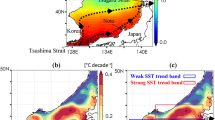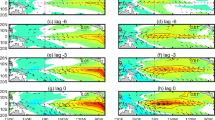Abstract
It has long been recognized that the evolution of marine storms may be strongly affected by the flux transfer processes over the ocean. High winds in a storm can generate large amounts of spray, which can modify the transfer of momentum, heat, and moisture across the air-sea interface. However, the role of sea spray and air-sea processes in western Pacific typhoons has remained elusive. In this study, the impact of sea spray on air-sea fluxes and the evolution of a typhoon over the western Pacific is investigated using a coupled atmosphere-sea-spray modeling system. Through the case study of the recent Typhoon Fengshen from 2002, we found that: (1) Sea spray can cause a significant latent heat flux increase of up to 40% of the interfacial fluxes in the typhoon; (2) Taking into account the effects of sea spray, the intensity of the modeled typhoon can be increased by 30% in the 10-m wind speed, which may greatly improve estimates of storm maximum intensity and, to some extent, improve the simulations of overall storm structure in the atmospheric model; (3) The effects of sea spray are mainly focused over the high wind regions around the storm center and are mainly felt in the lower part of the troposphere.
Similar content being viewed by others
References
Andreas, E. L., 1992: Sea spray and the turbulent air-sea heat fluxes.J. Geophys. Res.,97, 11429–11441.
Andreas, E. L., 1998: A new sea spray generation function for wind speeds up to 32 m/s.J. Phys. Oceanogr.,28, 2175–2184.
Andreas, E. L., 2003: An algorithm to predict the turbulent air-sea fluxes in high-wind, spray conditions. Preprints.12th Conf. on Interaction of the Sea and Atmosphere, Long Beach, CA, Amer. Meteor. Soc.
Andreas, E. L., and J. DeCosmo, 1999: Sea spray production and influence on air-sea heat and moisture fluxes over the open ocean.Air-Sea Exchange: Physics, Chemistry and Dynamics, G. L. Geernaert, Ed., Kluwer, 327–362.
Andreas, E. L., and K. A. Emanuel, 2001: Effects of sea spray on tropical cyclone intensity.J. Atmos. Sci.,58, 3741–3751.
Andreas, E. L., and J. DeCosmo, 2002: The signature of sea spray in the HEXOS turbulent heat flux data.Bound.-Layer Meteor.,103, 303–333.
Bao, J.-W., J. M. Wilczak, J.-K. Choi, and L. H. Kantha, 2000: Numerical simulations of air-sea interaction under high wind conditions using a coupled model: A study of hurricane development.Mon. Wea. Rev.,128, 2190–2210.
Benoit, R., M. Desgagne, P. Pellerin, Y. Chartier, and S. Desjardins, 1997: The Canadian MC2: A semi-implicit semi-Lagrangian wide-band atmospheric model suited for fine-scale process studies and simulation.Mon. Wea. Rev.,125, 2382–2415.
Bortkovskii, R. S., 1973: On the mechanism of interaction between the ocean and the atmosphere during a storm.Fluid Mechanics Soviet Research.,2, 87–94.
Chouinard, C., J. Mailhot, and A. Mitchell, 1994: The Canadian regional data assimilation system: Operational and research applications.Mon. Wea. Rev.,122, 1306–1325.
Fairall, C. W., J. D. Kepert, and G. J. Holland, 1994: The effect of sea spray on the surface energy transports over the ocean.The Global Atmosphere and Ocean System,2, 121–142.
Katsaros, K. B., S. D. Smith, and W. A. Oost, 1987: HEXOS-Humidity Exchange Over the Sea, A program for research on water-vapor and droplet fluxes from sea to air at moderate to high wind speeds.Bull. Amer. Meteor. Soc.,68, 466–476.
Kepert, J. D., C. W. Fairall, and J.-W. Bao, 1999: Modelling the interaction between the atmospheric boundary layer and evaporating sea spray droplets.Air-Sea Exchange: Physics, Chemistry and Dynamics, G. L. Greernaert, Ed., Kluwer, Dordrecht, 363–409.
Li, W., W. Perrie, E. L. Andreas, J. Gyakum, and R. McTaggart-Cowan, 2003: Impact of sea spray on numerical simulation of extratropical hurricanes. Preprints.12th Conf. On Interaction of the Sea and Atmosphere, Long Beach, CA, Amer. Meteor. Soc.
Ling, S. C., and T. W. Kao, 1976: Parameterization of the moisture and heat transfer process over the ocean under whitecap sea states.J. Phys. Oceanogr.,6, 306–315.
McTaggart-Cowan, R., J. R. Gyakum, and M. K. Yau, 2001: Sensitivity testing of extratropical transitions using potential vorticity inversions to modify initial conditions: Hurricane Earl case study.Mon. Wea. Rev.,129, 1617–1636.
Meirink, J. F., and V. K. Makin, 2001: Impact of sea spray evaporation in a numerical weather prediction model.J. Atmos. Sci.,58, 3626–3638.
Meng Zhiyong, Chen Lianshou, and Xu Xiangde, 2002: Recent progress on tropical cyclone research in China.Adv. Atmos. Sci.,19, 103–110.
Riehl, H., 1954:Tropical Meteorology. McGraw-Hill, New York, 392pp.
Robert, A., T. Yee, and H. Ritchie, 1985: A semiLagrangian and semi-implicit numerical integration scheme for multilevel atmospheric models.Mon. Wea. Rev.,113, 388–394.
Rouault, M. P., P. G. Mestayer, and R. Schiestel, 1991: A model of evaporating spray droplet dispersion.J. Geophys. Res.,96, 7181–7200.
Smith, S. D., 1988: Coefficients for sea surface wind stress, heat flux, and wind profiles as a function of wind speed and temperature.J. Geophys. Res.,93, 15467–15472.
Wang, Y., J. D. Kepert, and G. J. Holland, 2001: The impact of sea spray evaporation on tropical cyclone boundary layer structure and intensity.Mon. Wea. Rev.,129, 2481–2500.
Wu, J., 1973: Spray in the atmospheric surface layer: Laboratory study.J. Geophys. Res.,78, 511–519.
Wu, J., 1974: Evaporation due to spray.J. Geophys. Res.,79, 4107–4109.
Author information
Authors and Affiliations
Corresponding author
Rights and permissions
About this article
Cite this article
Li, W. Modelling air-sea fluxes during a western Pacific typhoon: Role of sea spray. Adv. Atmos. Sci. 21, 269–276 (2004). https://doi.org/10.1007/BF02915713
Received:
Revised:
Issue Date:
DOI: https://doi.org/10.1007/BF02915713




